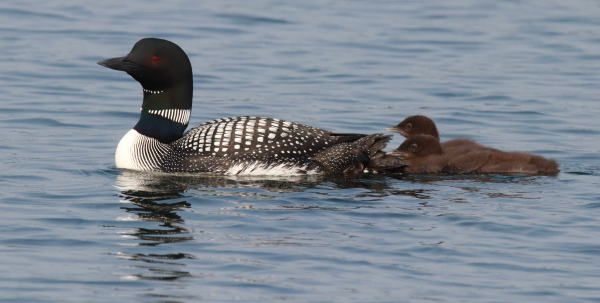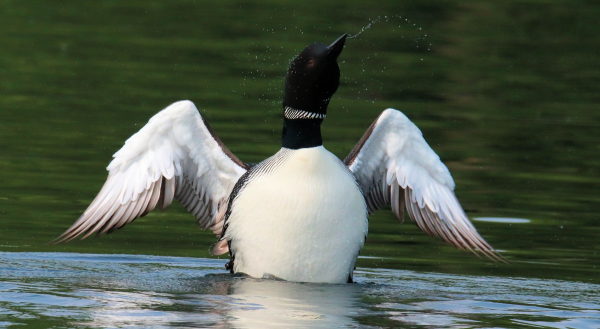Bird photography, like any form of photography, is all about lighting. The quality of the light that illuminates the birds before you and the scene you find them in will make or break a photo that is impressive in every other way. When photographing birds outdoors, I rely on the sun for optimum lighting, but it also takes optimum timing on my part. Timing for the best weather and sunshine conditions possible, and timing for when the best angle of the sunlight that will reach your subjects. If you have read my articles, you know I don’t usually try to photograph under cloudy conditions – usually.

Last week I had other things foremost in mind when I planned my circle trip through Minnesota, and leaving the weather and sunlight to chance, I was left with a cloudy morning at my favorite loon photography location at the lake outside my friend Andy’s home. But we wrote it off as a good day to do a little advance scouting to check on the potential for future loon photo sessions. It was also a good time to figuratively get our feet wet for the first time this season. All that changed though when we encountered a very unexpected surprise – a beautiful adult Common Loon with 2 new hatchlings!
That’s when I went into another mode, and it was a matter of documenting the birds in whatever light was available, even if the water was gray and the highlights of the feathers were dull. I actually didn’t have a photograph of a Common Loon or a pair with 2 hatchlings. Under the circumstances, the photos turned out quite nice, and I was happy to share the best of them with you in last week’s Bird Photography feature. But knowing there were loons to photograph, including at least one pair with downy young, a fire was burning inside me, and I went into planning and timing mode. When would the next sunny day happen when I was free from my editorial duties? What hours of the day were most likely to produce the best sunlight and blue sky to reflect blue water?

It's always a little iffy to try to look ahead using weather predictions as your guide, but as it turned out, last Tuesday looked like the perfect day of sunshine around Detroit Lakes, Minnesota; but that was my day to publish last week’s issue of The Birding Wire. Wednesday, on the other hand, had potential, but we might have passing clouds to contend with. Even so, I had that fire burning inside, and when Andy shared my enthusiasm for another loon photo cruise, it was set and we hoped for the best. Uncharacteristically, I didn’t sleep well that night, waking every hour, and I hopped outta bed earlier than usual to drive north, then east, arriving a little early at Andy’s lake abode.
During my morning drive to lakes country, there was hazy smoke from wildfires in Canada in the air on my way to the lakes, but it cleared up by the time we were boarding Andy’s luxury loon pontoon, and in the end we couldn’t have asked for a more beautiful conditions on the water. But it takes more than sunshine, blue sky and blue water, and the main ingredient was awaiting our arrival – Loons. As it turned out, we started photographing a pair near Andy’s home that was doing a lot of diving, then we found a single loon that did some serious long-range diving. By that time we were in the middle of Pelican Lake, a very large, long lake, and we decided to head south to check on a nesting platform that was used by Bald Eagles last year.

In that little bay we hit the jackpot, a pair of Common Loons with 2 new hatchlings. The adult pair was preoccupied with diving in the shallows below or near the floating hatchlings; the adults surfaced time and time again with very small fish or large insect larvae, which suggested a new behavior for me to photograph. Andy had already addressed the other most important thing about photographing in outdoor sunlight by positioning the boat so the sun was behind us and the loons were in front of us (with our shadows pointing toward the loons).
It was especially enjoyable to watch and photograph the ensuing interactions between the adults and new downys, but there was one little thing about the surroundings. The loons were positioned fairly close to the woodland shore, which reflected onto the water as a medium to dark green surface. Not the worst thing, considering the impressive interactions among the loon family that we were observing and photographing, all illuminated by beautiful sunlight. The time spent in the company of the young loons and watching the family interactions was a treasure, with the wind ceasing altogether at times, and the tranquil quite of the Northwoods only enhanced by an occasional birdsong. Andy even retired to a lounging position to absorb the essence of the period.

Soon the feeding activity slowed, as evidenced by the downy hatchlings resorting to short naps, waking only to accept another food morsel from the male as the female floated in company with the little ones. When the male joined the rest period and began preening, we decided to leave them to their evening activities and head back. But not before one adult raised up to spread its wings in an impressive flapping maintenance ruffle that that ended with it shaking its head, during when water droplets sprayed into the sunlight.
The lake was gloriously beautiful as we angled through the open midst of the calm, faint-blue lake water, and we remarked about how we couldn’t wish for a better situation as afternoon was turning to evening. Just then, Andy noticed a loon over my shoulder, and as I looked with binoculars there was an adult with 2 more newly hatched loons following – this time surrounded by the beautiful blue lake water. Realistically, this could be our ultimate chance to utilize all the best elements nature had to offer on a loon photo cruise, and Andy made a wide circle to reposition the pontoon between the sun and the loons, then hope to float closer or have the loons swim closer.

Even though we were still quite a distance away, the lone adult didn’t seem at ease in the midst of the open water, so Andy repositioned to a location a little in advance of where the adult was leading the downys, and that worked very well. With everything else in harmony for me to take some stunning photographs of the loons, I marveled at the beauty of the water surrounding the elegant loons through my camera lens. I imagined that the lone adult was the female, and that the male was probably fishing within earshot. As if to emphasize that point, the adult loon before us suddenly raised her head and neck and produced that iconic call of the Northwoods! What a spectacular way to end this photo cruise – perfecto!
The planning phase of photo outings is important, even if you only give it a few moments of thought; but with so many elements involved, planning and reality can be two different things. In this case, reality performed far beyond what we could have imagined, regardless of the level of advance planning. Simply put, it all came together: The sunlight, time of day, positioning with respect to the sun, the lack of wind, the color of the sky and water, and The Loons – indeed, the most important element, which is usually beyond any photographer’s ability to plan in advance or on the fly. Hooray, this story has a happy ending and a number of memorable images of “Loons in a Northwoods Lake.”

By the way, during the next 3 days it rained, remained overcast, and even became foggy at times with the increased humidity. Summer is a great season for birders to enjoy the great outdoors with binoculars and your camera while hiking, biking, canoeing, kayaking, boating, camping, relaxing. Enjoy the summer season, and celebrate Friday as the first day of Summer!
Article and Photographs by Paul Konrad
Share your bird photos and birding experiences at editorstbw2@gmail.com